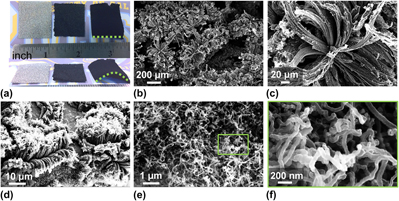Crossref Citations
This article has been cited by the following publications. This list is generated based on data provided by
Crossref.
Wang, Wei
Guo, Shirui
Bozhilov, Krassimir N.
Yan, Dong
Ozkan, Mihrimah
and
Ozkan, Cengiz S.
2013.
Intertwined Nanocarbon and Manganese Oxide Hybrid Foam for High‐Energy Supercapacitors.
Small,
Vol. 9,
Issue. 21,
p.
3714.
Razeghi, Manijeh
Lee, Young Hee
Ghazinejad, Maziar
Wang, Wei
Ruiz, Isaac
Ozkan, Mihrimah
and
Ozkan, Cengiz S.
2014.
Pillared graphene and silicon nanocomposite architecture for anodes of lithium ion batteries.
Vol. 9168,
Issue. ,
p.
91680M.
Favors, Zachary
Wang, Wei
Bay, Hamed Hosseini
George, Aaron
Ozkan, Mihrimah
and
Ozkan, Cengiz S.
2014.
Stable Cycling of SiO2 Nanotubes as High-Performance Anodes for Lithium-Ion Batteries.
Scientific Reports,
Vol. 4,
Issue. 1,
Abdulhakeem, Bello
Farshad, Barzegar
Damilola, Momodu
Fatemeh, Taghizadeh
Mopeli, Fabiane
Julien, Dangbegnon
and
Ncholu, Manyala
2014.
Morphological characterization and impedance spectroscopy study of porous 3D carbons based on graphene foam-PVA/phenol-formaldehyde resin composite as an electrode material for supercapacitors.
RSC Advances,
Vol. 4,
Issue. 73,
p.
39066.
Wang, Wei
Guo, Shirui
Lee, Ilkeun
Ahmed, Kazi
Zhong, Jiebin
Favors, Zachary
Zaera, Francisco
Ozkan, Mihrimah
and
Ozkan, Cengiz S.
2014.
Hydrous Ruthenium Oxide Nanoparticles Anchored to Graphene and Carbon Nanotube Hybrid Foam for Supercapacitors.
Scientific Reports,
Vol. 4,
Issue. 1,
Wang, Wei
Ruiz, Isaac
Ahmed, Kazi
Bay, Hamed Hosseini
George, Aaron S.
Wang, Johnny
Butler, John
Ozkan, Mihrimah
and
Ozkan, Cengiz S.
2014.
Silicon Decorated Cone Shaped Carbon Nanotube Clusters for Lithium Ion Battery Anodes.
Small,
Vol. 10,
Issue. 16,
p.
3389.
Chabi, Sakineh
Peng, Chuang
Hu, Di
and
Zhu, Yanqiu
2014.
Ideal Three‐Dimensional Electrode Structures for Electrochemical Energy Storage.
Advanced Materials,
Vol. 26,
Issue. 15,
p.
2440.
Wang, Wei
Favors, Zachary
Ionescu, Robert
Ye, Rachel
Bay, Hamed Hosseini
Ozkan, Mihrimah
and
Ozkan, Cengiz S.
2015.
Monodisperse Porous Silicon Spheres as Anode Materials for Lithium Ion Batteries.
Scientific Reports,
Vol. 5,
Issue. 1,
2015.
Nanostructured Carbon Materials for Catalysis.
p.
507.
Wang, Wei
Ruiz, Isaac
Lee, Ilkeun
Zaera, Francisco
Ozkan, Mihrimah
and
Ozkan, Cengiz S.
2015.
Improved functionality of graphene and carbon nanotube hybrid foam architecture by UV-ozone treatment.
Nanoscale,
Vol. 7,
Issue. 16,
p.
7045.
Liu, Chueh
Li, Changling
Ahmed, Kazi
Wang, Wei
Lee, Ilkeun
Zaera, Francisco
Ozkan, Cengiz S.
and
Ozkan, Mihrimah
2016.
Scalable, Binderless, and Carbonless Hierarchical Ni Nanodendrite Foam Decorated with Hydrous Ruthenium Dioxide for 1.6 V Symmetric Supercapacitors.
Advanced Materials Interfaces,
Vol. 3,
Issue. 6,
Wang, Wei
Favors, Zachary
Li, Changling
Liu, Chueh
Ye, Rachel
Fu, Chengyin
Bozhilov, Krassimir
Guo, Juchen
Ozkan, Mihrimah
and
Ozkan, Cengiz S.
2017.
Silicon and Carbon Nanocomposite Spheres with Enhanced Electrochemical Performance for Full Cell Lithium Ion Batteries.
Scientific Reports,
Vol. 7,
Issue. 1,
Rahmanabadi, F.
Sangpour, P.
and
Sabouri-Dodaran, A. A.
2019.
Electrochemical Deposition of MnO2/RGO Nanocomposite Thin Film: Enhanced Supercapacitor Behavior.
Journal of Electronic Materials,
Vol. 48,
Issue. 9,
p.
5813.
Smolianova, Inna
Hu, Jin-long
Zhao, Xin-yue
Dementiev, Viacheslav
and
Zhang, Ling-zhi
2020.
A high-capacity graphene/mesocarbon microbead composite anode for lithium-ion batteries.
Journal of Zhejiang University-SCIENCE A,
Vol. 21,
Issue. 5,
p.
392.
Szkoda, Mariusz
Zarach, Zuzanna
Trzciński, Konrad
and
Nowak, Andrzej P.
2020.
An Aqueous Exfoliation of WO3 as a Route for Counterions Fabrication—Improved Photocatalytic and Capacitive Properties of Polyaniline/WO3Composite.
Materials,
Vol. 13,
Issue. 24,
p.
5781.
Tang, Fanhao
He, Dongxu
Jiang, Hao
Wang, Rongshuo
Li, Zheling
Xue, Weidong
and
Zhao, Rui
2022.
The coplanar graphene oxide/graphite heterostructure-based electrodes for electrochemical supercapacitors.
Carbon,
Vol. 197,
Issue. ,
p.
163.



